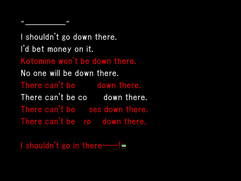 credit: TypeMoon credit: TypeMoon by Michael Nusspickel Multi-modal art has been gaining popularity among artists for the past decade, and it would be hard to argue that video games aren’t a means of creating a multi-modal experience for an audience. Within the genre of video games exists a niche sub-genre that logically should be the answer to many writer’s problems with choosing a medium, but it has barely been noticed (if at all) outside of the gaming community: the visual novel. Visual novels are novels that use visual and audio cues alongside text to communicate their content. A mix between graphic novels, video games, and pure prose, the visual novel allows a writer to have a product with visual art as an integral part of the storytelling but without sacrificing one’s prose for it. Text is delivered through speech boxes, backgrounds and characters are drawn, and sound and music add to the experience. Visual novels offer everything a graphic novel does, but with the ability to ignore a graphic novel’s layout limitations on word count. They originated in Japan but have been around for well over a decade at this point, so the question becomes: how come they haven’t caught on with Western writers?  credit: Wikispaces credit: Wikispaces It stands to reason that a mode of writing/art that gives you as many options like a visual novel would catch on with the avant garde crowd looking for new means of expression, but that’s simply not the case. There are a few reasons likely at fault, chief among them being the perceptions of video games as a medium for storytelling. While the last few years have seen a spike in the number of story centric games, to most they’re still that: games. You play them. Visual novels only use a game’s interface, its skeleton if you will, to deliver its text, so there isn’t really any “play” going on. You still have to run them through a computer program, however, so at a very quick glance there’s no difference. That assumption is far from the truth, however: visual novels are capable of delivering complex narratives using the choice-mechanics of a video game. By giving your audience the ability to make decisions, the author can create branching narratives that are difficult if not impossible to achieve in any other medium. You can have key events branch out to tell entirely different story lines that each contribute something important to the narrative as a whole, letting the author explore a myriad of themes without bogging down an individual story-path. It’s an incredibly powerful tool for the ambitious storyteller. The only visual novel to have notable popular success in the West has been the Phoenix Wright: Ace Attorney series. In these games you primarily are reading, with interactive puzzles and logical deductions mixed in. While marketed as games, the content of Phoenix Wright games is primarily first person prose. This formula may have managed to catch on with Western audiences due to following the conventions of both of its parent mediums: the stories told by the prose are static and uninfluenced by player decisions, while the game play is puzzle based. One interacts as a gatekeeper to the other: to turn the page, you have to do what it asks of you. The issue is that these games only skim the surface of what the medium of a visual novel is capable of as a literary vehicle by sticking to a static narrative. Examples that do use the artistic options available to the visual novel, however, struggle to find any market with Western audiences. The major stumbling block seems to be rooted in the same reason that choose-your-own-adventure books don’t stay with you when you grow up: they’re considered childish. The medium also faces difficulties getting exposure with Western audiences due to its foreign nature, but its status as a “game” make it even more difficult to market. Its marketed audience is not the literary or academic types who would benefit from being exposed to the structure of the medium, and that gives it an extremely limited and niche foothold on our shores. That’s a shame, since many of the more artistic writers in universities and avant garde circles are itching for multi-modal writing, and a mutable structure for it is sitting right under their noses. Writers already use the internet to create different, complicated texts that ask the reader to be fairly involved in the experience: hyper-linked stories where each link takes you to another part of the narrative, pieces where the text reveals itself as you interact with it, or even a poetry cube. The tools for those who would like a longer but multifaceted work exist, and the options for literature creation are vast. So how do you get literary, artistic people to read a visual novel? Simply importing them hasn’t worked, so the next step is to get an incredible, homegrown visual novel that utilizes the structure in a way that it becomes a shining example. Something that tells a complicated narrative, perhaps by branching the story at certain points, but each branch explores a different (but related) set of themes. It doesn’t matter what it does, other than demonstrate that this structure is viable and worthy of notice.
0 Comments
Leave a Reply. |
Archives
July 2024
Categories
All
|
|
Glassworks is a publication of Rowan University's Master of Arts in Writing 260 Victoria Street • Glassboro, New Jersey 08028 [email protected] |
All Content on this Site (c) 2024 Glassworks
|

 RSS Feed
RSS Feed
